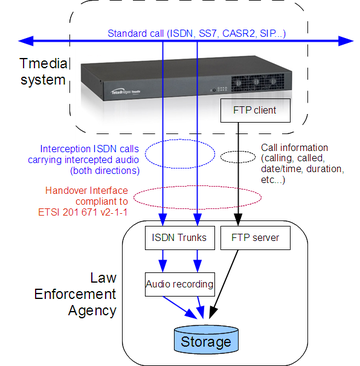Intercept Related Information
From TBwiki
Revision as of 04:55, 3 October 2016 by William Wong (Talk | contribs)
The call data (known as Intercept Related Information or IRI in Europe and Call Data or CD in the US) consists of information about the targeted communications, including destination of a voice call (e.g., called party’s telephone number), source of a call (caller’s phone number), time of the call, duration, etc.
Contents |
IRI records
- Lawful Interception, a feature as provided by service providers to law enforcement agencies, allows law enforcement agencies to intercept calls
- By firstly having law enforcement agency meeting Lawful Interception Requirements:
- Law enforcement agency provides a list of targets
- LIID (unique identifier) for the target
- Phone number (calling or called number) of the target
- Start/end date and time for the interception
- Service provider updates targets list in it’s equipments
- The equipments detect a matching calling or called number, and activates the interception
- By firstly having law enforcement agency meeting Lawful Interception Requirements:
then,
- By receiving a copy of the audio of both parties, through CC link (forked call)�which is a call toward the agency, carrying intercepted audio
- By receiving call information records (or IRI records)
- Intercept Related Information record (IRI record) is a CDR-style record that contain IRI information on an intercepted call
IRI records generating
- IRI records are generated at various states of the interception
- They provide information on the interception, and call state
- In a call, each call leg can be an interception target
- When a leg is an interception target, it’s intercepted:
- Audio «from» this leg is forked to a new outgoing call toward the agency
- Audio «to» this leg is forked to a new outgoing call toward the agency
- IRI records are generated for this interception
- Both legs may be independently and simultaneously intercepted
- 2 pairs of forked audio outgoing calls
- 2 sets of IRI records
Types of IRI records
- Start: Indicate that the interception is starting at first event of the communication attempt
- Continue: Indicate call state change at any time during the communication (attempt)
- End: Indicate the end of the interception at the end of the communication (attempt)
- Report: For any non-communication related events
Typical information found in an IRI record
- Record type (Start, Continue, End, Report)
- LIID (unique identifier of the intercepted target assigned by an agency)
- CIN (communication identity number)
- Operator identifier
- Direction (target is originating, or terminating)
- Call state (idle, setup, connected)
- Duration of ring and conversation states
- Calling / called party numbers
- Release reason
- CC link state (setup, active, released, lack of resources)
- CC link release reason
IRI records encoding
- IRI records are encoded in ASN.1 format
- ASN.1 IDs and objects hierarchy for encoding IRI records is provided by ETSI specifications
IRI records values and files specification
- IRI records values can be
- Mandatory in each record
- In one record only for the whole call
- optional (in some records only, or none at all)
- IRI record files can
- Contain only one IRI record (one file per record)
- Contain multiple IRI records (grouped)
IRI records uploading to the agency
- As files, using the FTP protocol
- Telcobridges supports SFTP as file transfer method as well
